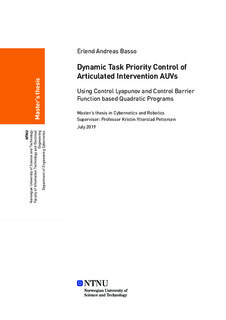| dc.contributor.advisor | Pettersen, Kristin Ytterstad | |
| dc.contributor.author | Basso, Erlend Andreas | |
| dc.date.accessioned | 2019-10-31T15:15:21Z | |
| dc.date.issued | 2019 | |
| dc.identifier | no.ntnu:inspera:35771502:18528852 | |
| dc.identifier.uri | http://hdl.handle.net/11250/2625768 | |
| dc.description.abstract | Artikulerte intervensjons-autonome undervannsfarkoster (AIAUV-er) har oppstått ved å utstyre undervanns slangeroboter (USR-er) med sideveis- og langsgående propeller. AIAUV-er er overaktuerte og svært redundante undervannsmanipulatorer, hvor hele dens artikulerte kropp fungerer som en flytende flerleddet manipulatorarm. Denne oppgaven er motivert av den redundante og overaktuerte AIAUV-en, og omhandler prioritert regulering av redundante robotsystemer. Sammenhengen mellom dynamisk nullromsbasert regulering og multivariabel (MIMO) linearisering ved tilbakekobling undersøkes, hvor kriteriene for inngang-utgang linearisering og full-tilstand linearisering er gitt. Dynamisk nullromsbasert regulering fusjoneres med kontrollbarrierefunksjoner (CBF-er) i et forsøk på å designe en dynamisk regulator som støtter mengdebaserte reguleringsopppgaver. Fusjonen resulterer i et optimaliseringsbasert rammeverk hvor streng prioritet mellom reguleringsoppgaver ikke lengre kan garanteres. Dynamisk nullromsbasert regulering droppes dermed og en reguleringsmetode basert på et hierarki av kontroll Lyapunovfunksjon- (CLF) og kontrollbarrierefunksjon-baserte kvadratiske programmer (QP-er) er utviklet. Dette optimaliseringsbaserte rammeverket sikrer streng prioritet mellom ulike grupper av reguleringsoppgaver som sikkerhetsrelaterte, operasjonelle og optimaliseringsoppgaver, noe som innebærer at oppgaver med lavere prioritet ikke har noen effekt på gjennomføringen av alle høyere prioriterte oppgaver. Videre kan et mykt prioritetsmål i form av innstillbare straffeparametere benyttes for å prioritere oppgaver på samme prioritetsnivå. I motsetning til kinematiske regulatorer er det foreslåtte rammeverket en helhetlig tilnærming til styring av AIAUV-er hvor redundansoppløsning, dynamisk regulering og kontrollallokering tas hånd om samtidig. | |
| dc.description.abstract | The articulated intervention autonomous underwater vehicle (AIAUV) has emerged from the underwater snake robot (USR) by equipping it with longitudinal and tunnel thrusters. The AIAUV is an overactuated and highly redundant underwater floating base manipulator, where its entire articulated body serves as a floating manipulator arm, and its slender shape allows it to access narrow and confined spaces. Motivated by the redundant and overactuated AIAUV, this thesis is concerned with prioritized control of redundant robotic systems. Operational space control is investigated in the context of multiple-input and multiple-output (MIMO) feedback linearization, where conditions for input-output linearizability and full-state linearizability by an operational space control law are given. With the goal of including set-based tasks within a dynamic task priority framework, operational space control is merged with control barrier functions (CBFs). However, strict priority between tasks is lost in the process. As a consequence, operational space control is not pursued further and a novel task priority framework based on a hierarchy of control Lyapunov function (CLF) and control barrier function based quadratic programs (QPs) is developed. This framework ensures strict priority among different groups of control tasks such as safety related, operational and optimization tasks, which entails that tasks with a lower priority have no effect on the execution of all higher priority tasks. Moreover, a soft priority measure in the form of tunable penalty parameters can be employed to prioritize tasks at the same priority level. In contrast to kinematic control schemes, the proposed framework is a holistic approach to AIAUV control which solves the redundancy resolution, dynamic control and control allocation problems simultaneously. | |
| dc.language | eng | |
| dc.publisher | NTNU | |
| dc.title | Dynamic Task Priority Control of Articulated Intervention AUVs using Control Lyapunov and Control Barrier Function based Quadratic Programs | |
| dc.type | Master thesis | |
